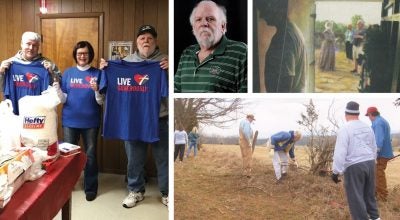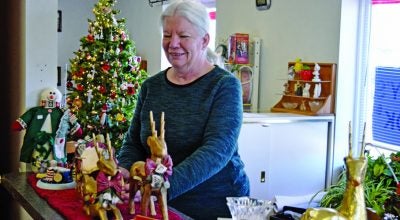Students win with essays
Published 9:09 am Monday, January 7, 2013
Two students from Dawson-Bryant Elementary and a student from St. Lawrence Elementary are this year’s winners of the Lawrence County Historical Society’s essay contest.
Taking first place was Cameron Deere from Lori Deer’s class at Dawson-Bryant for his essay on the Waterloo Wonders. Second place was awarded to Jackson Rowe from Julie Walters’s class at St. Lawrence for an essay on Ironton founder John Campbell. Third place went to Sophie Reid, also from Deer’s class at Dawson-Bryant, for her work on the Ironton-Russell Bridge. First place winner received $50; second place, $25 and third place, $10. All students are fourth graders.
The Waterloo Wonders: The Fabulous Five
By Cameron Deere
The story of the Waterloo Wonders is the most interesting story I have ever heard. It is about five white boys, about 5’ 1”, who loved to play the game of basketball. They were not just a normal team like we have today.
They were boys from the country who were so poor that they learned to handle the ball by using rags tied together in the shape of a ball. They couldn’t dribble, so they had to learn to pass and work as a team to make baskets. They didn’t let this get them down. They even won back-to-back Ohio Class B Championships in 1934-1935.
The members of the Fabulous Five, which was their nickname, were Wyman Roberts, Curtis McMahon, Orlyn Roberts, Stewart Wiseman, and Beryl Drummond. Their coach was Magellan Hairston. After watching this team play, people all over Ohio knew where Waterloo was. It was a small farming town, northeast of Ironton. There is not much there today, but back in the 1930’s, this team made it popular.
People have compared this team to the Harlem Globetrotters. They would pull all kinds of pranks. Wyman Roberts would usually be the one to start to the pranks, and then the others would join in. It has been said that during games when they were beating a team very badly, a couple of team members would stop and eat hot dogs in the stands. Once, they even started playing marbles during a game!
They would do this while the other members were continuing to play. Another time, there was a smart-mouth in the crowd yelling, “shoot the ball!” When the team heard this, they turned and shot the ball to the smart-mouth! I am sure the crowd went wild.
Even though they liked to get a lot of laughs, the coach would not let them get out of hand or be mean. One time, a player said something, and Coach Hairston “popped him right in the head.” They had respect for one another. If a team member broke a training rule, the other members would get with the coach and decide on a punishment.
For example, once Wyman was loafing in practice so the team decided to put him on the best shooter in the next game. If Wyman was outscored, then he was off the team! This kept them in line. The Wonders usually played many games during a season. Most were far away. Seven of them, the coach, the scorekeeper, and the five players, would all pile in a car and drive to the games. Beryl was the smallest, so he would have to lie down across the other player’s feet in the back. One story is that they were on their way to a game near Cleveland, and it started to snow.
The coach called to say they might not be able to make it in time to play, but they still wanted the team to come. They didn’t get there until 11 p.m. that night, but the gym was still packed full of fans waiting to see the Fabulous Five.
During the 1934-1935 season, the team played 100 games with 97 wins and 3 losses. The crazy thing is that they lost to Greenfield McClain, Franklin, and Ironton High School. This was one of the years that they won the state championship. After they graduated from high school, many colleges wanted them to come and play for them. Stewart Wiseman was the only one to go to college and play ball. The other four ended up turning pro and played as the Waterloo Wonders. They played great teams such as the New York Renaissance Five, the Philadelphia Sphas, and even the New York Celtics.
The Waterloo Wonders is a very interesting story. It makes it even cooler that it was from Lawrence County. This story shows you that even people from small towns can do great things.
History of John Campbell
By Jackson Rowe
John Campbell, the founder of Ironton was born on Jan. 14, 1808 and founded Ironton in 1849. John Campbell was raised as a farm boy in Georgetown, Ohio. In 1828 he began his professional life as a store clerk. After saving approximately $600, he invested in the Ohio River steamer, the Banner, and became its clerk. He sold his interest in the steamer on his second trip to Pittsburgh. In 1832 he met Robert Hamilton, who was the main Hanging Rock iron man, and he hired him as the Pinegrove Furnace clerk.
In 1834, he and Robert Hamilton built the Mount Vernon Furnace and he moved there to manage it. Though he stayed for some years, his interest in the iron business grew. The first hot blast furnace that was erected in America was at the Vesuvius Furnace in 1841. Also the first boilers and hot blast put over the furnace stack was his idea. This was the fourth furnace he was involved with building.
In 1844, he and John Peters built Greenup Furnace in Kentucky; in 1846 he built Olive Furnace; and in 1847, Gallia. In 1853, he assisted in building Howard and Washington furnaces, and in 1854 he built Madison. In 1856, he built his last furnace which was Monroe. He later purchased and owned interests in other furnaces notably Hecla Furnace.
About 1845, Mr. Campbell moved from Mt. Vernon Furnace to Hanging Rock where he lived until 1851, when he moved to the new town of Ironton, which he organized two years before. He built a home on Fifth and Lawrence streets which is now the Community Action Organization building.
All the while he was building some of his first furnaces, he had a great scheme in his mind. He organized the Ohio Iron and Coal Co. on April 23, 1849. He thought if there is to be a town with a railroad, it should also be a town with a name. He called the new town, Ironton, which means iron by the ton. On June 20 the first land sale was held for the public. This was the beginning of Ironton.
On March 16, 1837 Mr. Campbell married Miss Elizabeth Caldwell Clarke. They had seven children: Mary J, Martha, Emma, Clara, Albert, and Charles Campbell, who survived at the time of their father’s death, except Mary and Emma, and the baby who died during infancy.
I’m thankful that John Campbell founded Ironton and helped lead our area in the iron industry.
The Ironton-Russell Bridge
By Sophie Reid
The Ironton-Russell Bridge opened April 21, 1922. The bridge was the first highway bridge along the Ohio River between Parkersburg, W.Va. and Cincinnati. It was painted light blue and had two lanes for traffic. The bridge connected the city of Ironton to Russell, Ky. According to Ironton’s economic director Bill Dickens, the bridge was originally made to go over the Mississippi River so people could travel from St. Paul to Minneapolis, Minn.
They cancelled the bridge at the last minute so the Wisconsin Bridge Company needed a city to buy it. Ironton raised more than $700,000 by selling bonds to buy the bridge.
The method of construction, materials that were used, and the complexity of the trusses make this bridge a historical artifact.
Bridges built in the present age may look the same, but are not built with the extent of engineering and specialized work. The trusses and bracing make this structure beautiful and a rare piece of art.
By 1999 over 11,250 cars went over the bridge daily. In the summer of 2001, the bridge underwent one million dollars in repairs.
The Ohio Department of Transportation has decided that this rare, beautiful, and historic bridge must be demolished and replaced.
On May 18, 2004 the Ohio Division of Wildlife were inspecting the bridge to identify two peregrine falcon chicks nesting on the bridge.
When they got closer, they actually found three. The chicks were named Honor, Patience and Sergeant. These falcons were an endangered bird at this time. The Ohio Department of Natural Resources banded the baby birds and put them back in the nest.
These birds are some of the fastest on earth. They are able to fly at a speed of up to 242 miles per hour. They have been known to swoop down and peck pedestrians on the head, so the walkway on the bridge had to be closed.
Many bridges were considered for the replacement of the Ironton-Russell Bridge. In January 2003 a final design was picked. The cost would be 110 million dollars. Since this was too expensive a few changes had to be made to reduce the cost. This new bridge is being built now close to where the old bridge still stands.




